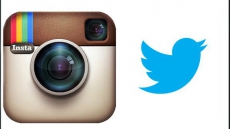TORONTO — Will 2015 be the year that virtual reality goes from sci-fi fantasy to real world play thing?
Facebook thinks so, having spent more than US$2 billion to acquire the company Oculus VR, which is expected to release a potentially game-changing virtual reality headset next year. Samsung and Sony are racing to release their own virtual reality gear too.
Virtual reality is part of a booming wearable technology industry that took steps toward a big breakout in 2014. But it's really expected to explode in 2015.
Here's a look at a few tech trends that could make a huge leap in the year ahead — along with a few that fizzled out in 2014.
VIRTUAL REALITY
Facebook founder Mark Zuckerberg calls Oculus' virtual reality technology "a new communication platform."
Looking a bit like oversized ski goggles, the company's Oculus Rift headset transports users into a virtual world.
When you turn your head, the device's video screen seamlessly responds to the motion so it feels like you're actually peering around in the virtual world.
The technology is still in the very early stages but a quick demo makes its promise immediately apparent.
The producers behind the recently aired TV documentary "The Polar Sea" created a stunning Oculus-compatible virtual reality experience of the northern lights as seen from a beach in the Arctic.
Zuckerberg has suggested that sports fans could one day watch a game in virtual reality from the vantage point of the best seats in a stadium.
In the U.S., Samsung just released its Gear VR headset, which is also powered by Oculus technology. The $200 headset pairs with a Galaxy Note 4 smartphone to run virtual reality content. Samsung called the device an "Innovator Edition," signalling that it's for eager early adopters and not quite ready for prime time. No release date has been set for Canada.
Sony is also working on a VR headset, nicknamed Project Morpheus, and you can expect other companies will rush their own products to market sometime in 2015.
Another phase for the technology will involve connecting VR headsets to other body sensors, so users can see and control their own hands while experiencing a virtual reality setting.
WEARABLES
Wearable technology isn't new.
Innovators like University of Toronto Prof. Steve Mann have been experimenting with wearables for decades, while some mass market products such as the FitBit fitness trackers have been available to consumers for years.
But 2015 promises to be the year that the market is flooded with products from the wearables industry, from virtual reality gear, to electronic wristbands, to smart-watches. Research company IDC Canada is predicting a 70 per cent year-over-year increase in shipments of wearables products to 1.2 million by the end of 2015.
Apple is expected to release its long awaited (and simply named) Watch sometime next year, which could kick start the smart-watch industry. So far, plenty of smart-watches have been released to the market by the likes of Samsung, Sony and Canadian upstart Pebble, but consumer demand has been relatively muted.
But if anyone can make smart-watches the next big thing overnight, it's Apple.
STREAMING VIDEO
It's already huge but expect the popularity of streaming video to grow even more in 2015.
The TV industry in the U.S. is anxiously awaiting HBO's big move next year. The cable network known for producing premium top-tier content announced in October that it plans to offer a stand-alone streaming service that would not require a TV subscription.
Could that be the final straw that turns cord cutting into a legitimate trend?
Earlier this year, the Toronto-based Convergence Consulting Group estimated as many as 6.23 million U.S. households — or 6.2 per cent of all homes — would be going without a TV subscription by the end of this year.
In Canada, the estimate was up to 665,000 Canadian households, or 5.7 per cent of all homes, would have cut the cord by the end of 2014.
Netflix has certainly had a major impact in spurring cord cutting so far. The Media Technology Monitor estimated that one in three anglophone Canadians were subscribing to Netflix in the spring. Shomi, launched by Rogers and Shaw earlier this year, is available without a TV subscription and should gain traction in 2015. Bell's CraveTV isn't available to cord cutters but should help boost the streaming trend.
Then there's YouTube, which is becoming the go-to source of entertainment for many teens who are increasingly idolizing online personalities instead of traditional TV or film stars.
Continued growth in smartphone and tablet ownership should also lead to more mobile streaming of video. It's already common to see bus or train passengers streaming a TV show or YouTube clips to make their trip home feel a little quicker.
BUSTS OF 2014
— Cyber security. From mundane hacking of individuals' email or social media accounts to high-profile breaches of corporate servers, online crime was a growing concern this year. The likes of Target and Home Depot had embarrassing data breaches they had to report to customers, and governments around the world — including here in Canada — are struggling to keep up with growing attempts by hackers to infiltrate their systems. Now 2014 is ending with Sony mired in a crisis as it tries to contain the fallout of an attack by a group identifying itself as the "Guardians of Peace." Expect companies and governments to put a larger focus on cyber security in 2015 after so many alarming breaches this year.
— Amazon's Fire Phone, released in the U.S. in July, was a complete bust and served as an example of how difficult it has become to do well in the smartphone market. With the exception of Apple, most smartphone makers are struggling. BlackBerry and Microsoft barely register as competitors to Apple and even Samsung, known for its popular line of Galaxy Android-based phones, is watching its sales and market share sink. Research firm Gartner reported this month that Samsung went from having a third of the global smartphone market in the third quarter of last year to about a quarter of it in 2014. Xiaomi and Huawei have emerged as leaders in China and are increasingly courting international buyers.
— It would be inaccurate to say Bitcoin was a total bust in 2014. A lot of venture capital money was poured into start-up companies that want to popularize the electronic currency. And established brands want to get in on the trend early too. Just last week, magazine publisher Time said it would start accepting Bitcoin payments for subscriptions to publications including Fortune, Health, This Old House and Travel + Leisure. But if you bought Bitcoin in January, your investment would be worth only a third as much today. One Bitcoin was priced at about US$950 in the first week of January but has since dropped to the low-$300 range.





